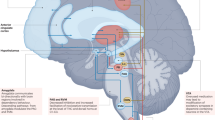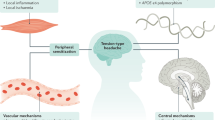Abstract
Tension-type headache (TTH) is the most prevalent primary headache disorder. An important factor in the long-term prognosis of TTH is the overuse of acute medications used to treat headache. There are many reasons why patients with TTH overuse acute medications, including biobehavioral influences, dependency, and a lack of patient education. Chronic daily headache occurs in 4.1% of the general population, and chronic tension-type headache and medication overuse headache (MOH) occur in approximately 2.2% and 1.5%, respectively. A proper diagnosis is essential for the treatment of these patients. Treatment should include pathological considerations concerning TTH and MOH, which include peripheral and central mechanisms. Because TTH with MOH carries the worst prognosis, more clinical studies focusing on the complex interaction and treatments of TTH and MOH are needed.
Similar content being viewed by others
References and Recommended Reading
Lenaerts M: Burden of tension-type headache. Curr Pain Headache Rep 2006, 10:459–462.
Silberstein S, Liu D: Drug overuse and rebound headache. Cur Pain Headache Rep 2002, 6:240–247.
Headache Classification Subcommittee of the International Headache Society: The International Classification of Headache Disorders, 2nd edn. Cephalalgia 2004, 24(Suppl 1):1–60.
Headache Classification Committee of the International Headache Society: Classification and diagnostic criteria for headache disorders, cranial neuralgias and facial pain. Cephalalgia 1988, 8(Suppl 7):1–96.
Lyngberg AC, Rasmussen BK, Jorgensen T, Jensen R: Secular changes in health care utilization and work absence for migraine and tension-type headache: a population based study. Eur J Epidemiol 2005, 20:107–114.
Lake A: Medication overuse headache: biobehavioral issues and solutions. Headache 2006, 46(Suppl 3):S88–S97.
Saper JR, Hamel RL, Lake AE: Medication overuse headache (MOH) is a biobehavioral disorder. Cephalalgia 2005, 25:545–546.
Scher Al, Stewart WF, Ricci JA, Lipton RB: Factors associated with the onset and remission of chronic daily headache in a population-based. Headache 1998, 38:497–506.
Castillo J, Munoz P, Guitera V: Epidemiology of chronic daily headache in the general population. Headache 1999, 39:190–196.
Schwartz BS, Stewart WF, Simon D, et al.: Epidemiology of tension-type headache. JAMA 1998, 279:381–383.
Pascual J, Colas R, Castillo J: Epidemiology of chronic daily headache. Curr Pain Headache Rep 2001, 5:529–536.
Rassmussen BK, Jensen R, Schroll M, Olesen J: Epidemiology of headache in a general population: a prevalence study. J Clin Epidemiol 1991, 44:1147–1157.
Bigal ME, Serrano D, Buse D, et al.: Acute migraine medications and evolution from episodic to chronic migraine: a longitudinal population-based study. Headache 2008, 48:1157–1168.
Schnider P, Aull S, Feucht M, et al.: Use and abuse of analgesics in tension-type headaches. Cephalalgia 1994, 14:162–167.
Diener HC, Dahlof CGH: Headache associated with chronic use of substances. In The Headaches, edn 2. Edited by Olesen J, Tfelt-Hansen P, Welch KMA. Philadelphia: Lippincott Williams and Wilkins; 1999:871–878.
Aaseth K, Grande RB, Lundqvist C, et al.: Interrelation of chronic tension-type headache with and without medication overuse and migraine in the general population: the Akershus study of chronic headache. Cephalalgia 2009, 29:331–337.
Ulrich V, Russell M, Jensen R, Olesen J: A comparison of tension-type headache in migraineurs and in non-migraineurs: a population-based study. Pain 1996, 67:201–206.
Headache Classification Committee of the International Headache Society: New appendix criteria open for a broader concept of chronic migraine. Cephalgia 2006, 26:742–746.
Sancisi E, Cevoli S, Pierangeli G, et al.: Application of ICHD-II and revised diagnostic criteria to patients with chronic daily headache. Neurol Sci 2007, 28:2–8.
Ghiotto N, Sances G, Galli F, et al.: Medication overuse headache and applicability of the ICHD-II diagnostic criteria: 1-year follow-up study (CARE I protocol). Cephalalgia 2009, 29:233–243.
Katasarva Z, Fritsche G, Muessig M, et al.: Clinical features of withdrawal headache following overuse of triptans and other headaches drugs. Neurology 2001, 57:1694–1698.
Mathew NT, Kurman R, Perez F: Drug induced refractory-clinical features and management. Headache 1990, 30:634–638.
Bigal M, Lipton RB: Tension-type headache: classification and diagnosis. Curr Pain Headache Rep 2005, 9:423–429.
Lew HL, Lin PH, Fuh JL, et al.: Characteristics and treatment of headache after traumatic brain injury: a focused review. Am J Phys Med Rehabil 2006, 85:619–627.
Forsyth PA, Posner JB: Headaches in patients with brain tumors: a study of 111 patients. Neurology 1993, 43:1678–1683.
Bendtsen L: Central sensitization in tension-type headache-possible pathophysiological mechanisms. Cephalalgia 2000, 20:486–508.
Jensen R: Mechanisms of tension-type headache. Cephalalgia 2001, 21:786–789.
Dodick DW, Silberstein SD: Central sensitization theory of migraine: clinical implications. Headache 2006, 46(Suppl 4):S182–S191.
Bigal MF, Ashina S, Reed ML, et al.: Prevalence and characteristics of allodynia in headache sufferers a population study. Neurology 2008, 70:1525–1533.
Ji RR, Woolf C: Neuronal plasticity and signal transduction in nociceptive neurons: implications for the initiation and maintenance of pathological pain. Neurobiol Dis 2001, 8:1–10.
Cupini L, Calabresi P: Medication-overuse headache: pathophysiological insights. J Headache Pain 2005, 6:199–202.
Ayzenberg I, Obermann M, Nyhuis P, et al.: Central sensitization of the trigeminal and somatic nociceptive systems in medication overuse headache mainly involves cerebral supraspinal structures. Cephalalgia 2006, 26:1106–1114.
Park JW, Kim JS, Kim YI, et al.: Serotoninergic activity contributes to analgesic overuse in patients with chronic tension-type headache. Headache 2005, 45:1229–1235.
Cevoli S, Sancisi E, Grimaldi D, et al.: Family history of chronic headache and drug overuse as a risk factor for headache chronification. Headache 2009, 49:412–418.
Diener HC, Limmroth V, Katsarava Z: Medication overuse headache. In Chronic Daily Headache for Clinicians. Edited by Goadsby PJ, Silberstein SD, Dodick DW. Hamilton, Ontario, Canada: BC Decker, Inc.; 2005:117–127.
Young WB, Siow HC: Should butalbital-containing analgesics be banned? Yes. Curr Pain Headache Rep 2002, 6:151–155.
Limmroth V, Katasarva Z, Fritsche G, et al.: Features of medication overuse headache following overuse of different acute headache drugs. Neurology 2002, 59:1011–1014.
Felice M, Porreca F: Opiate-induced persistent pronociceptive trigeminal neural adaptations: potential relevance to opiate-induced medication overuse headache. Cephalalgia 2009 May 11 (Epub ahead of print).
Calabresi P, Cupini L: Medication-overuse headache: similarities with drug addiction. Trends Phamacol Sci 2005, 26:62–68.
Fumal A, Laureys S, Di Clemente L, et al.: Orbitofrontal cortex involvement in chronic analgesic-overuse headache evolving from episodic migraine. Brain 2006, 129:543–550.
Rossi P, Di Lorenzo C, Faroni J, et al.: Advice alone vs structured detoxification programmes for medication overuse headache: a prospective, randomized, open-label trial in transformed migraine patients with low medical needs. Cephalalgia 2006, 26:1097–1105.
Reljia G, Granato A, Bratina A, et al.: Outcome of medication overuse headache after abrupt in-patient withdrawal. Cephalalgia, 2006, 26:589–595.
Hagen K, Albretsen C, Vilming ST, Salvesen R et al.: Management of medication overuse headache: 1 year randomized multicentre open-label trial. Cephalalgia 2008, 29:221–232.
Diener HC, Bussone G, Van Oene JC, et al.: Topiramate reduces headache days in chronic migraine: a randomized, double-blind, placebo-controlled study. Cephalalgia 2007, 27:814–823.
Stillman M: Pharmacotherapy of tension-type headaches. Curr Pain Headache Rep 2002, 6:408–409.
Dodick DW, Silberstein SD: How clinicians can detect, prevent, and treat medication overuse headache. Cephalalgia 2008, 28:1209–1217.
Marmura M, Rosen N, Abbas M, Silberstein SD: Intravenous lidocaine in the treatment of refractory headache: a retrospective case series. Headache 2009, 49:286–291.
Grazzi L, Andrasik F, D’Amico D, et al.: Behavioral and pharmacological treatment of transformed migraine with analgesic overuse: outcome at 3 years. Headache 2002, 42:483–490.
Katasarva Z, Muessig M, Dzagnidze A, et al.: Medication overuse headache: rates and predictors for relapse in a 4-year prospective study. Cephalalgia 2005, 25:12–15.
Schnider P, Aull S, Baumgartner C, et al.: Long term outcome of patients with headache and drug abuse after inpatient withdrawal: five year follow-up. Cephalalgia 1996, 16:481–485.
Author information
Authors and Affiliations
Corresponding author
Rights and permissions
About this article
Cite this article
Monteith, T.S., Oshinsky, M.L. Tension-type headache with medication overuse: Pathophysiology and clinical implications. Current Science Inc 13, 463–469 (2009). https://doi.org/10.1007/s11916-009-0075-0
Published:
Issue Date:
DOI: https://doi.org/10.1007/s11916-009-0075-0




